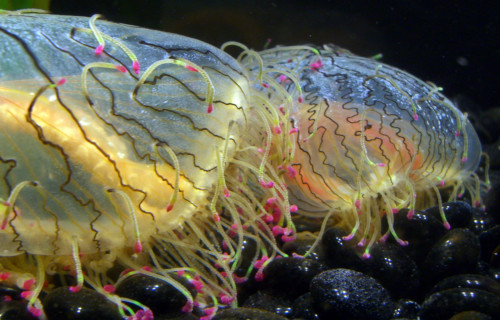
CCL: https://bit.ly/33EsplL
We sincerely hope that you enjoy this article about 7 Supremely Scintillating Cnidaria. While the name of the phylum might be difficult to pronounce, the species within it remain some of the most memorable on the entire planet. Some of them, though, are less known than others. It is our fervent hope that this article will bring a few of them to your awareness. Of course, these 7 Supremely Scintillating Cnidaria represent just a small portion of the more than 9,000 different species within this amazing phylum.
Fried Egg Jellyfish
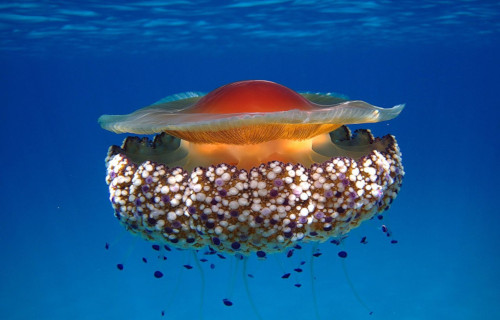
CCL: https://bit.ly/37KNKuI
Fried Egg Jellyfish Facts
- Leading off this article about 7 Supremely Scintillating Cnidaria is the tantalizing species commonly known as the Fried Egg Jellyfish.
- Most notably, several different species of jellyfish, in various parts of the world, go by the same unique common name. The species referred to in this article, however, bears the cumbersome scientific name of the Cotylorhiza tuberculata. But, the amazing creature also possesses yet another common name. That holds true due to the fact that some people know the animal as the Mediterranean Jellyfish.
- Fortunately for humans, this magnificent Cnidarian separates itself from its relatives in an important way. That’s because, unlike the majority of cnidarians, its sting poses no particular threat to humans. Quite unfortunately, the reverse does not remain the case. That’s because its annual blooms interfere with human water sport activities. As a result, vast numbers are forcibly removed from their habitat.
- Luckily for it, however, the Fried Egg Jellyfish reproduces in great numbers. As a result of this biological proclivity, its number appear to remain stable, for the moment. Therefore, the IUCN currently has no listing for this creature. But that could change in the foreseeable future. It doubtless facing the same potential threats as other sea-dwellers. These potential dangers mainly consist of pollution, and of course, climate change.
Fried Egg Jellyfish Physical Description
First of all, regardless of other factors involved, the overall size of the amazing Fried Egg Jellyfish must be noted. That’s because, its incredible appearance notwithstanding, the remarkable species ranks as a roughly average-sized cnidarian.
This statement holds true due to the maximum attained size of individuals observed to date. That holds true because the largest studied specimens attained a disk diameter of about 16 in (40 cm). However, most individuals only average a measurement of about 6.7 in (17 cm).
In addition to this, its central dome remains surrounded by a deep-set ring. The numerous transparent cilia it develops often vary significantly in appearance between individuals. Many have a rounded end. Further, these also achieve differing lengths, creating a layered effect.
However, the appearance of the central disk of the Fried Egg Jellyfish obviously remains its most remarkable physical feature. This holds true due to its coincidental resemblance to a fried egg. This, therefore, understandably, serves as the source of its common name.
- Kingdom: Animalia
- Phylum: Cnidaria
- Class: Scyphozoa
- Order: Rhizostomeae
- Family: Cepheidae
- Genus: Cotylorhiza
- Species: C. tuberculata
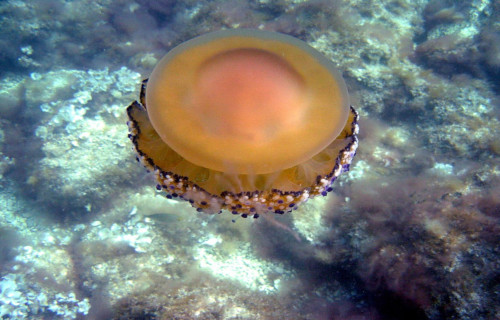
CCL: https://bit.ly/37GKH6C
Fried Egg Jellyfish Distribution, Habitat, and Ecology
Firstly, the magnificent cnidarian known to many as the Fried Egg Jellyfish inhabits a moderately large range. That’s because it appears in three separate seas of the world. These consist of Aegean Sea, the Adriatic Sea, and the Mediterranean Sea.
However, the wondrous creature currently remains most numerous in one highly specific region. Further, that region consists of certain portions of the Mediterranean Sea. There, it appears most commonly in the waters near the countries of Italy, Monaco, and Greece, in Europe.
Furthermore, this marvelous animal inhabits the portion of the worlds’ seas known as the pelagic zone. Within that region, however, it moves back and forth from shallow to deeper regions. That’s because it approaches the surface at night, mainly to feed.
The truly gorgeous Fried Egg Jellyfish has a diet consistent with most other known cnidarians. As a result, it feeds mainly on extremely tiny sea life. Most commonly, this consists of a combination of zooplankton and phytoplankton.
Pacific Sea Nettle
Pacific Sea Nettle Facts
- The second species appearing in this compendium of 7 Supremely Scintillating Cnidaria is the amazing Pacific Sea Nettle.
- Firstly, the wonderful animal remains an ocean-dwelling species which many mistakenly consider dangerous. However, this marvelous creature actually poses no serious threat to humans. In fact, barring an allergic reaction, its sting rarely ranks as no more than irritating.
- Secondly, since it represents a multi-stage life form, this creature actually evolved the ability to reproduce in different ways. That holds true because individuals can reproduce sexually in a total of two ways. That’s sexually in the medusa stage, and asexually in the polyp stage.
- Meanwhile, this marvelous creature separates itself from others in another way. While many species have dwindled in recent decades, the Pacific Sea Nettle has actually increased in numbers. In parts of its range, its numbers have become considered hazardous to boating.
- In addition, for the moment, at least, this amazing species does not appear on the Red List of Threatened Species, published by the IUCN. This holds true because its numbers actually appear to be either stable, or perhaps increasing. Nevertheless, it remains considered to be at risk due to ongoing climate change.
Pacific Sea Nettle Physical Description
Although it amazes due to its great beauty, among other reasons, the Pacific Sea Nettle only ranks as a medium-sized species of true jellyfish. The species hold this ranking because of the size of its bell. This quite impressive feature of the creature attains a maximum diameter of just over 3 ft (1 m). Further, it typically displays a distinctive golden-brown color with a reddish tint.
The remarkable animal known as the Pacific Sea Nettle also has long white oral arms. Furthermore, it also develops 24 mobile, maroon colored tentacles. These fascinating appendages sometimes attain lengths of as much as 15 ft (4.6 m). In addition, each of those tentacles contains thousands of tiny stingers. These the creature uses to inject its venom into the prey.
- Kingdom: Animalia
- Phylum: Cnidaria
- Class: Scyphozoa
- Order: Semaeostomeae
- Family: Pelagiidae
- Genus: Chrysaora
- Species: C. fuscescens
Pacific Sea Nettle Distribution, Habitat, and Ecology
Quite unfortunately, the endemic range of the beautiful Pacific Sea Nettle remains somewhat restricted. That’s because, as the name implies, it consists of a rather specific portion of the Pacific Ocean. More specifically, however, this endemic habitat range extends from the coast of Mexico to Canada, in North America.
First of all, the impressive creatures possess the ability to dwell at comparatively moderate depths. Nevertheless, the vast majority of individuals typically remain near the surface. What’s more, the species typically prefers to float on the surface, allowing the waves to move them.
While there, the resourceful animal spreads its versatile tentacles wide and consumes captured prey. This prey most commonly consists of a combination of zooplankton, crustaceans, and various small fish. In turn, the Pacific Sea Nettle itself often falls prey to either seabirds or large fish.
Finally, in recent years, the animal has become extremely plentiful off the coast of Oregon, in the United States. Although scientists have not determined the reason for this, one leading theory suggests that current environmental factors may play a key role in this quite surprising development.
Flower Hat Jellyfish

CCL: https://bit.ly/33EsplL
Flower Hat Jellyfish Facts
- The third selection for inclusion on this roster of 7 Supremely Scintillating Cnidaria is the stunning Flower Hat Jellyfish.
- First of all, the highly descriptive term applied to this species serves as the common name for the visually stunning Olindias formosus. However, despite its name and incredible appearance, this creature does not qualify as a true variety of jellyfish. That’s due to the fact that this truly stunning creature actually represents a particularly colorful species of hydrozoan. Further, true jellyfish in fact belong to the family Scyphozoa.
- Quite fortunately, this small but remarkably impressive animal rarely has any interaction with mankind. Furthermore, on the rare occasion when the extremely reclusive creature does interact with humans, this usually occurs when many individuals have grouped together. When such groupings do occasionally occur, the term science applies to them is blooms. Generally, its sting poses no direct threat to human beings.
- Also quite fortunately, for the moment its population numbers appear to be comparatively abundant and relatively stable. Therefore, the IUCN does not presently list the Flower Hat Jellyfish on its Red List of Threatened Species. Nevertheless, this sincerely fascinating ocean invertebrate doubtless faces the same threat that now faces many species throughout the world. That peril, of course, would be that of ongoing climate change.
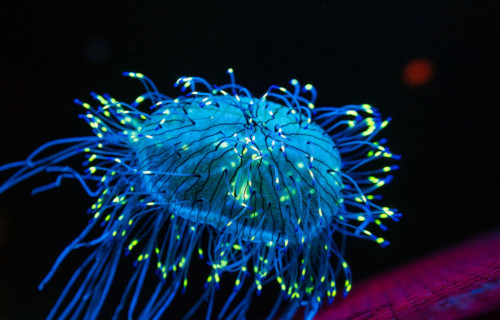
CCL: https://bit.ly/33Ddati
Flower Hat Jellyfish Physical Description
Most notably, the gorgeous Flower Hat Jellyfish perfectly proves the point that size has no relation to beauty. That’s true because this visually magnificent hydrozoan remains a physically small example of its Class. In fact, its bell only attains a maximum width measuring about 6 in (15 cm).
Further, that same bell is what earns the fabulous sea creature its common name. That’s because some people feel it resembles a hat made from a flower. This outer structure remains primarily translucent in appearance. But, numerous opaque bands also appear on the bell, extending vertically .
However, the many tentacles of the Flower Hat Jellyfish themselves garner much-deserved attention themselves. That’s due to their highly distinctive appearance. Firstly, these evolved as somewhat fluorescent in nature. Further, each of them displays a complex pattern of brilliant colors. But, the exact pattern varies between individuals.
- Kingdom: Animalia
- Phylum: Cnidaria
- Class: Hydrozoa
- Order: Limnomedusae
- Family: Olindiidae
- Genus: Oilindias
- Species: O. formosus
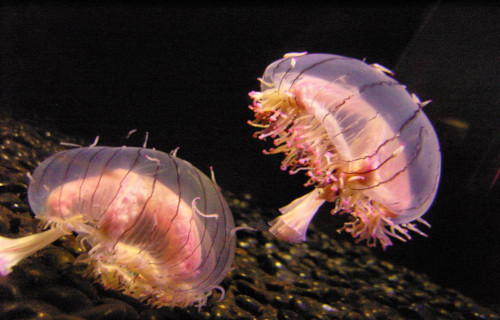
CCL: https://bit.ly/2vI60Hy
Flower Hat Jellyfish Distribution, Habitat, and Ecology
The Flower Hat Jellyfish remains a highly colorful species of jellyfish principally native to a small area in the Western Pacific Ocean. More precisely, this area lies off the coast of Japan, in Asia. In point of fact only a small handful of scattered individuals have been found in other locations.
However, a minor mystery surrounds this aspect of the life of the amazing species. That’s because, other than around Japan, sightings of a few individuals occurred near Argentina and Brazil, in South America. Current theory supposes that human activities accidentally transplanted these few individuals.
The magnificent animals also appear to prefer a highly specific habitat, as well. That’s because the majority of those observed lived either on or near the ocean floor. It also prefers moderate depths and warmer temperatures. Furthermore, the species typically stays in or near ares of seagrass and kelp beds.
The Flower Hat Jellyfish primarily feeds upon a variety of species of small fish. Most also occasionally consume small marine invertebrates which it typically scoops from the ocean floor. Its remarkable tentacles also serve a dual function for feeding. Finally, its lifespan only averages about 4 – 6 months.
Lion’s Mane Jellyfish
Lion’s Mane Jellyfish Facts
- Our next choice of species to place in this article pertaining to 7 Supremely Scintillating Cnidaria is the stunning Lion’s Mane Jellyfish.
- First of all, one specific fact about the remarkable Lion’s Mane Jellyfish remains the most notable of all details of the animal. That’s the simple fact that this awesome creature represents the largest of all known types of jellyfish. However, it does not constitute the longest known type of cnidarian in the world. That claim belongs to another species.
- Bearing the scientific name of Cyanea capillata, this fabulous animal also continues to be the source of some debate within the scientific community. That’s because zoologists do not completely agree on its taxonomy. Due to this disagreement, some population in different parts of the world receive different species assignments in some publications.
- Quite fortunately, the amazing Lion’s Mane Jellyfish appears to be maintaining a large and stable population, at least for the moment. Therefore, the IUCN presently has no listing for in on its Red List. However, the species does face several threats to its continued existence. These potential dangers such factors as boat strikes, and of course climate change.
Lion’s Mane Jellyfish Physical Description
Without doubt, the most notable thing about the supremely gorgeous Lion’s Mane Jellyfish remains its sheer physical size. That’s because the impressive body of this invertebrate attains a maximum known width measuring about 7 ft (2.13 m). However, an average size for this remarkable species equals roughly 6.5 ft (2 m).
Furthermore, these impressive tentacles represent yet another of the several amazing physical characteristic of this species. That’s due to the fact that these appendages average a length of about 100 ft (30 m). But, a few exceptional specimens have possessed tentacles measuring a staggering 120 ft (36.6 m) in total length.
Furthermore, these fascinating features of the animal grow in eight separate and distinct clusters. In addition, each of these tightly grouped clusters themselves contains anywhere from 70 – 150 of the individual tentacles. The central bell from which these spring also divides into eight separate lobes.
Additionally, the coloring of individual specimens of the Lion’s Mane Jellyfish appears to change with age. Firstly, smaller and younger specimens generally display tan or light orange colors. Yet, as it grows, the color deepens. As a result of this process, the oldest and largest individuals tend to be dark purple or crimson.
- Kingdom: Animalia
- Phylum: Cnidaria
- Class: Scyphozoa
- Order: Semaeostomeae
- Family: Cyaneidae
- Genus: Cyanea
- Species: C. capillata
Lion’s Mane Jellyfish Distribution, Habitat, and Ecology
The magnificent Lion’s Mane Jellyfish evolved as native to a restricted area of the world. That holds true due to the fact that evolution birthed it in the region comprising the northern Atlantic Ocean, and the northern Pacific Ocean. Further, the majority of known individuals live in the Irish Sea, the North Sea, the English Channel, and into some western Scandinavian waters.
Nevertheless, even within this limited zone of habitation, the impressive creature has decided habitat preferences. That’s because it typically lives within a very specific range of depths. Further, this range extends from just below the surface of the water to a depth of roughly 66 ft (20.1 m). As a result, the ever-present ocean currents frequently carry it great distances, much like the Velella.
Like other cnidarians, the awesome Lion’s Mane Jellyfish evolved as a carnivore. For this purpose, its tentacles serve it quite well. These appendages sting and capture its prey. Although this varies depending on exact location, it generally consists of a wide range of fish species, and even smaller jellyfish. In turn its own predators mainly include sea turtles, seabirds, and larger fish.
Much like the related Pacific Sea Nettle, this species reproduces both sexually and asexually. Furthermore, it goes through four distinct life stages. Sequentially, these consist of the larval, polyp, ephyrae, and medusa stages. Once laid, females carry the eggs in the tentacles until old enough to be set on a hard surface. Once mature, an average lifespan equals about one year.
Tiburonia granrojo
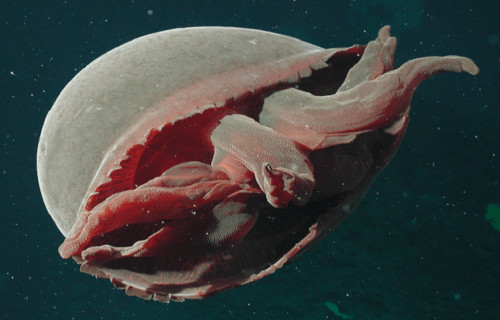
Photo: NOAA/Monterey Bay Aquarium Research Institute
Public Domain Image
Tiburonia granrojo Facts
- The magnificent Tiburonia granrojo places fifth among our picks for 7 Supremely Scintillating Cnidaria, but only due to random selection.
- Most notably, the completely astonishing sea creature stands out from related creatures for one remarkable reasons. That’s because it represents a newly discovered form of truly unique jellyfish. This incredible find also makes for a new genus, a remarkable discovery.
- However, this incredible find doesn’t simply represent a new species. In point of fact, the fascinating animal also represents an entirely previously unknown genus. The first recognition as a possible new discovery occurred in 1998, to the astonishment of many scientists.
- Furthermore, subsequent reviews of underwater films identified it as having been observed as early as 1993. However, it required extensive study and analysis before a final conclusion could be arrived at. As a result of this , the final confirmation of its status did not occur until 2010.
- Quite unfortunately, scientists know very little about the Tiburonia granrojo. That’s because, to date, a total of only 23 individuals have been sighted, and only one specimen has been captured for study. Due to the understandable lack of date, the IUCN currently has no listing for it.
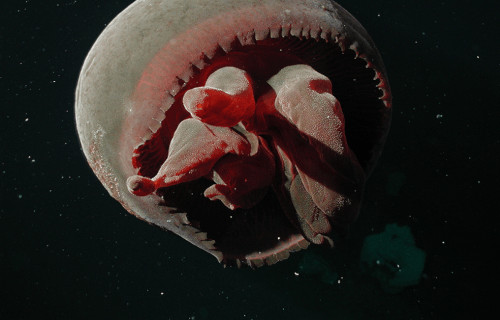
CCL: https://bit.ly/1ryPA8o
Tiburonia granrojo Physical Description
Quite unfortunately, the lamentable lack of fully reliable data also extends to the physical characteristics of the Tiburonia granrojo. Since the number of specimens studied remains so low, some facts and principles remain uncertain. Among these is if those observed represent a statistically sufficient number to state traits with certainty.
Consequently, all physical measurements of the species, among other facts, may be subject to revision at a later date. For the moment, however, some deductions on the part of researchers exist. First of all, unlike related creatures, this astonishing animal does not possess long, slender tentacles. Instead it develops thick, fleshy arms.
In addition, the amazing Tiburonia granrojo also ranks among the largest of the known varieties of jellyfish. This holds true because, based on the few specimens seen, it appears to attain a diameter of up to 30 in (75 cm). Further, in color, the animal presents a deep red, in contrast to the virtually transparent nature of other jellyfish.
- Kingdom: Animalia
- Phylum: Cnidaria
- Class: Scyphozoa
- Order: Semaeostomeae
- Family: Ulmaridae
- Genus: Tiburonia
- Species: T. granrojo
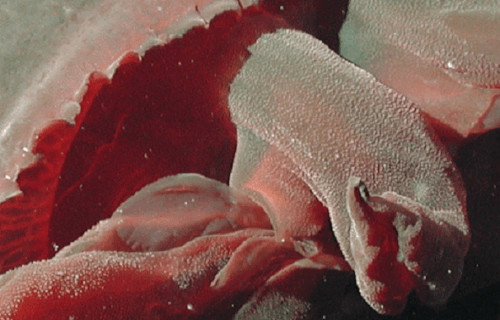
Public Domain Image
Tiburonia granrojo Distribution, Habitat, and Ecology
Sadly, another of the things of which researchers remain uncertain about concerning the Tinburonia granrojo is its complete habitat range. That’s because, to date, its only known habitats include the Pacific Ocean, Sea of Cortez, Monterey Bay, and off the shores of Japan and Hawaii. For now, it’s far too soon to know if this forms the entirety of its range or not.
Additionally, yet again, scientists cannot state categorically the precise nature of its preferred habitat. But, since every observation of individuals to date occurred within a certain range, this seems likely to be its natural range. So far, all known specimens dwelt at depths of between 2,000 – 4,900 ft (600 – 1,500 m). This qualifies the incredible life form as a deep-dwelling species.
Furthermore, given the lack of detailed information, its precise diet also cannot be officially confirmed. Nonetheless, it seems reasonable to assume that its diet would be at least similar to other cnidarians. Therefore, the amazing Tiburonia granrojo most likely preys on a variety of small sea cretures. Finally, and sadly, no detailed data pertaining to its life cycle yet exists.
Portuguese Man O’ War
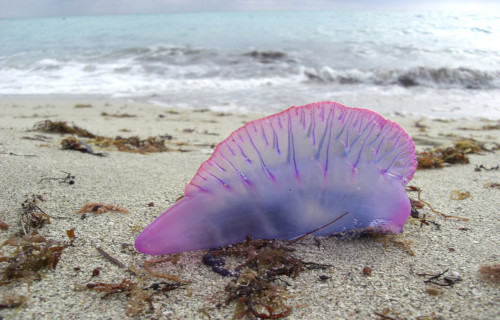
CCL: https://bit.ly/33JOMq2
Portuguese Man O’ War Facts
- Next up among these awesome choices for 7 Supremely Scintillating Cnidaria is the infamous Portuguese Man O’ War.
- Firstly, the well-known and sincerely amazing species now, as it has always been, remains a particularly dangerous variety of marine hydrozoan. This holds true due to a particularly remarkable physical capacity. That’s the fact that its numerous tentacles have the capacity to deliver multiple highly toxic stings to its prey. These stings also rank as extremely painful.
- Secondly, despite its jellyfish-like physical appearance, this fascinating creature does not, in fact, represent a species of true jellyfish. In fact, this rather intriguing species actually constitutes a type of life form known as a siphonophore. This makes the animal a colonial being, whereas a true jellyfish actually represents an individual multicellular creature.
- Furthermore, the impressive species bears the somewhat unimpressive scientific name of Physalia physalis. However, it remains much more widely known by its attention-grabbing common name, the Portuguese Man O’ War. Quite understandably, it earned this name due to its supposed resemblance to an 18th-century sailing ship.
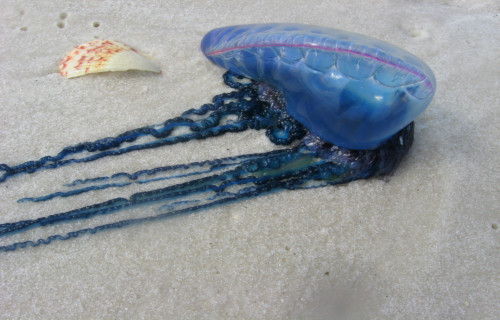
CCL: https://bit.ly/2WGHSQH
Portuguese Man O’ War Physical Description
It must be pointed out that individuals of the Portuguese Man O’ War most commonly vary quite significantly in terms of overall physical size. Furthermore, this frequent variation in mature size is one that it shares with many related species. Nevertheless, certain physical dimensions remain reasonably consistent among most of the specimens observed.
First of all, its inflatable sack typically measures about 12 in (30.5 cm) in length. This feature further measures an average of 5 in (12.7 cm) in overall width. The remarkable hydrozoan also displays a prominent sail on its upperside. This growth can be as long as 11.8 in (30 cm) long and stand up to 6 in (5 cm) tall. It also displays color patterns of purple, pink, blue, and mauve.
However, the astonishing tentacles of the gorgeous and impressive Portuguese Man O’ War represent the feature for which it remains best known That holds true mainly due to their sheer length. This occurs because these tentacles attain an average length measuring roughly 165 ft (50.3 m). These extensive appendages contain the animals’ powerful venom.
- Kingdom: Animalia
- Phylum: Cnidaria
- Class: Hydrozoa
- Order: Siphonophorae
- Family: Physaliidae
- Genus: Physalia
- Species: P. physalis
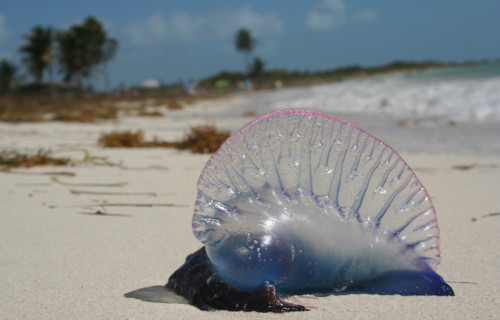
CCL: https://bit.ly/2J6Gdfi
Portuguese Man O’ War Distribution, Habitat, and Ecology
The sincerely magnificent animal known commonly as the Portuguese Man O’ War also stands out due to its habitat range, as well as for other reasons. That’s because it inhabits a very broad range of the world. More specifically, it appears in the Pacific Ocean, Indian Ocean, and Atlantic Ocean. This makes it among the most widely distributed of all known cnidarians.
Regardless of where it appears, however, it has quite simple but specific habitat preferences. This holds true due to the fact that it lives its life entirely on the surface of the ocean. Furthermore, its gas-filled bladder, known to science as the pneumatophore, stays on the surface. That’s because this part keeps the creature afloat. The rest of its body remains submerged.
The numerous tentacles drag along beneath and behind the Portuguese Man O’ War, floating freely. This occurs because of the nature of the creature. That’s because this fascinating species possesses no means of independent motion. It remains entirely at the mercy of he wind, waves, and ocean currents for its movement. As a result, its movements remain completely random.
This surprising invertebrate evolved solely as a carnivorous species. The dangerous tentacles it develops serve as its means of acquiring food. The toxins these secrete paralyzes and often kills the numerous small fish that it preys upon. Although not typically fatal to humans directly, multiple stings can cause paralysis. This can prove fatal if the human victim is in deep water.
Turritopsis Nutricula
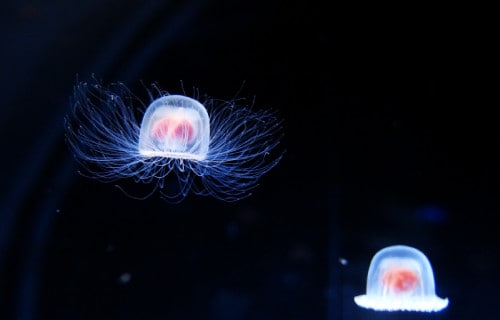
CCL: http://bit.ly/2OUHszC
Turritopsis Nutricula Facts
- For the seventh entry out of these 7 Supremely Scintillating Cnidaria, we have saved the most awesome for last, the Turritopsis Nutricula.
- Most notably, the truly astonishing Turritopsis Nutricula remains one of the most astounding species ever discovered by science. Such a grand statement must be supported by fact, of course. And, in this case, at least, the carefully researched facts appear to completely support the statement. Further, exhaustive ongoing research so far confirms those facts.
- First of all, this truly amazing variety of hydrozoan has no common name, just the scientific one. Nevertheless, its name remains on the tongue of researchers around the world. That holds true due to one mind-boggling fact about its physiology. That’s because, thanks to an unparalleled development of evolution, individuals appear to be effectively immortal.
- However, exceptions to this remarkable condition do exist. Any Turritopsis Nutricula can be killed, of course, such as if by a predator. Indeed, over the course of time it can be presumed that eventually all specimens fall victim to predation. But, due to its astonishing gift from evolution, no member of the species appears to die due to old age. Unfortunately, very few quality photographs of the animal exist.
Turritopsis Nutricula Physical Description
Firstly, it must be pointed out that, despite its astonishing nature, the Turritopsis Nutricula remains a very small type of hydrozoan. That holds true due to the fact that its adult body attains a small diameter. In fact, that small body, called the bell, only averages roughly 0.18 in (4.5 mm) in total width. It also develops about 80 -90 short tentacles, used for hunting and protection.
Furthermore, in keeping with the pattern of many related species, one aspect of its appearance stands out. That’s that the body of the surprising animal remains mainly translucent. However, an interior structure generally displays a bright color. But, this color varies between individuals. Nevertheless, the most common hues appear to be shades of red and yellow.
In addition, the sincerely marvelous creature known as the Turritopsis Nutricula qualifies as what science calls a colonial life form. That’s because its tiny body actually consists of numerous tiny, highly specialized individual creatures. In addition, these bond together to form a composite entity. Further, each component literally cannot live apart from the whole.
- Kingdom: Animalia
- Phylum: Cnidaria
- Class: Hydrozoa
- Order: Anthoathecata
- Family: Oceaniidae
- Genus: Turritopsis
- Species: T. nutricula
Turritopsis Nutricula Distribution, Habitat, and Ecology
Quite unsurprisingly, the truly incredible Turritopsis Nutricula evolved as native to only a very small portion of the world. More specifically, that highly restricted native range consists of the Caribbean. However, due to the actions of man, the species now appears in the waters of many other parts of the world. In fact, individuals have been found along the east coast of the United States, in North America, and along the coast of Europe.
Since it evolved as native to the Caribbean, the animal obviously prefers warmer waters. Further, it most commonly stays either at or near the surface of the water. This, therefore, serves as the reason for its dispersal to other parts of the world. That’s because, for unknown reasons, it likes to attach itself to the bottom of boats. However, those individuals transplanted to other regions of the world do not proliferate as well as those in its native area.
Given its small size, the Turritopsis Nutricula understandably has a somewhat restricted diet. As a result, this small carnivore feeds primarily on a combination of fish eggs, small mollusks, and plankton. But its immortality remains its most interesting trait. This occurs due to an astounding ability. At apparently random times, adult individuals initiate a still unknown process. This literally results in all parts of the creature reverting to an immature state.

CCL: https://bit.ly/37KNKuI
7 Supremely Scintillating Cnidaria
We truly hope that you have thoroughly enjoyed this article about 7 Supremely Scintillating Cnidaria. Species such as these have fascinated many of us throughout our lives. Some have even influenced literature. But these, and many other species around the world, now find themselves imperiled. It is up to us to do all that we can to protect and preserve species such as these 7 Supremely Scintillating Cnidaria, and countless others, for future generations.
Check out our other articles on 7 Highly Unusual Lakes, Pea Crab, Lake Toba, Sea Butterfly, Bleeding Tooth Fungus, Tiger Rattlesnake, Tasmanian Giant Freshwater Crayfish
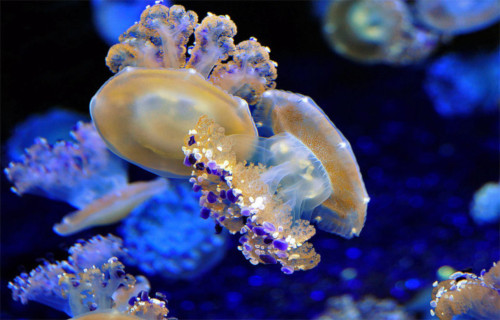
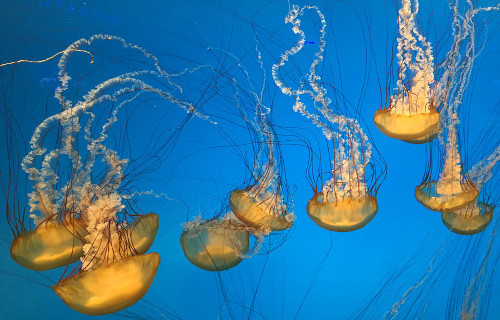
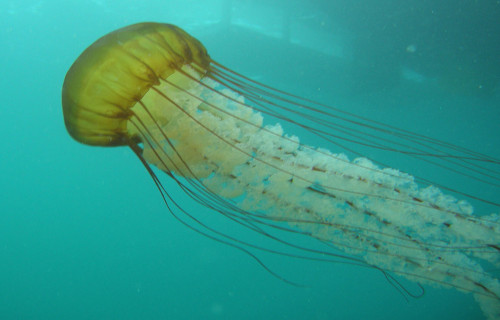
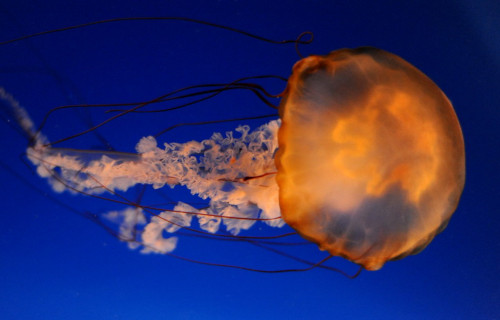
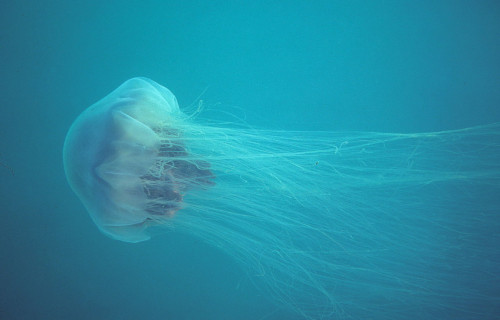
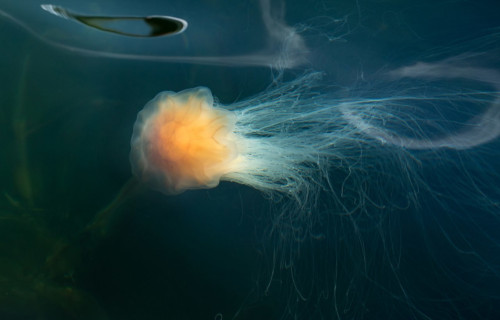









Leave a Reply